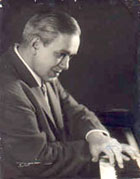9.5.1 Ernesto Lecuona.

Ernesto Lecuona, a prominent Cuban musician, was born in the Guanabacoa municipality of Havana on August 7, 1895. He was a composer, pianist, and conductor. He studied with Ernestina Lecuona, Carlos Alfredo Peyrellade, Joaquín Nin, and Hubert de Blanck. He began playing piano at the age of five, and composed his first works at the age of twelve. He was a notable virtuoso on his instrument.
He spread the highlights of the Cuban lyrical repertoire throughout Europe and America, performing his own piano works and those of other composers on all his tours. His musical output includes plays, songs, and piano pieces.
Among his most popular plays are María La O, Rosa la China, El Cafetal, Lola Cruz, Niña Rital, and El Sombreo de Yarey. These works have made him one of the most important composers of Cuban lyrical theater.
His piano works occupy another essential place within Cuban music. Their integral character is subject to the historical and social context of the time in which they were composed. He wrote pieces so that beginners at any conservatory could perform them at conservatory events or to liven up family gatherings. He even made simplified versions of his more demanding works to make this possible.
Lecuona’s work enjoyed an uneven distribution, resulting in a predominance of commercial appeal, especially in songs like “Siboney” and “Siempre en mi Corazón.” Within his piano literature and his vocal and piano work, we find a valuable output that reflects a different style of composition, in which, without abandoning the spontaneity and nature of his musical language, the genius and talent of a great composer emerge. Lecuona has left us more than 180 works for piano.
Ernesto Lecuona’s waltz is full of expressive elements and elaborate techniques typical of Cuban music, incorporated organically, giving it a special flavor. They display the broad, brilliant pianism characteristic of its composer’s style.
His Six Cuban Dances, written at different times, were published in the 1920s. Their names refer to themes directly related to Cuban folklore of African origin. La Comparsa premiered in 1912, when the composer was only 17 years old. These highly expressive dances trace new approaches to piano procedure, conditioned by the complex integration of their structures, in which the rhythmic factor constitutes the triggering element for all the components in the syntactical relationships of the sound fabric. They reflect a new code of expressive treatment in Cuban piano music.
Ernesto Lecuona died on November 29, 1963.








